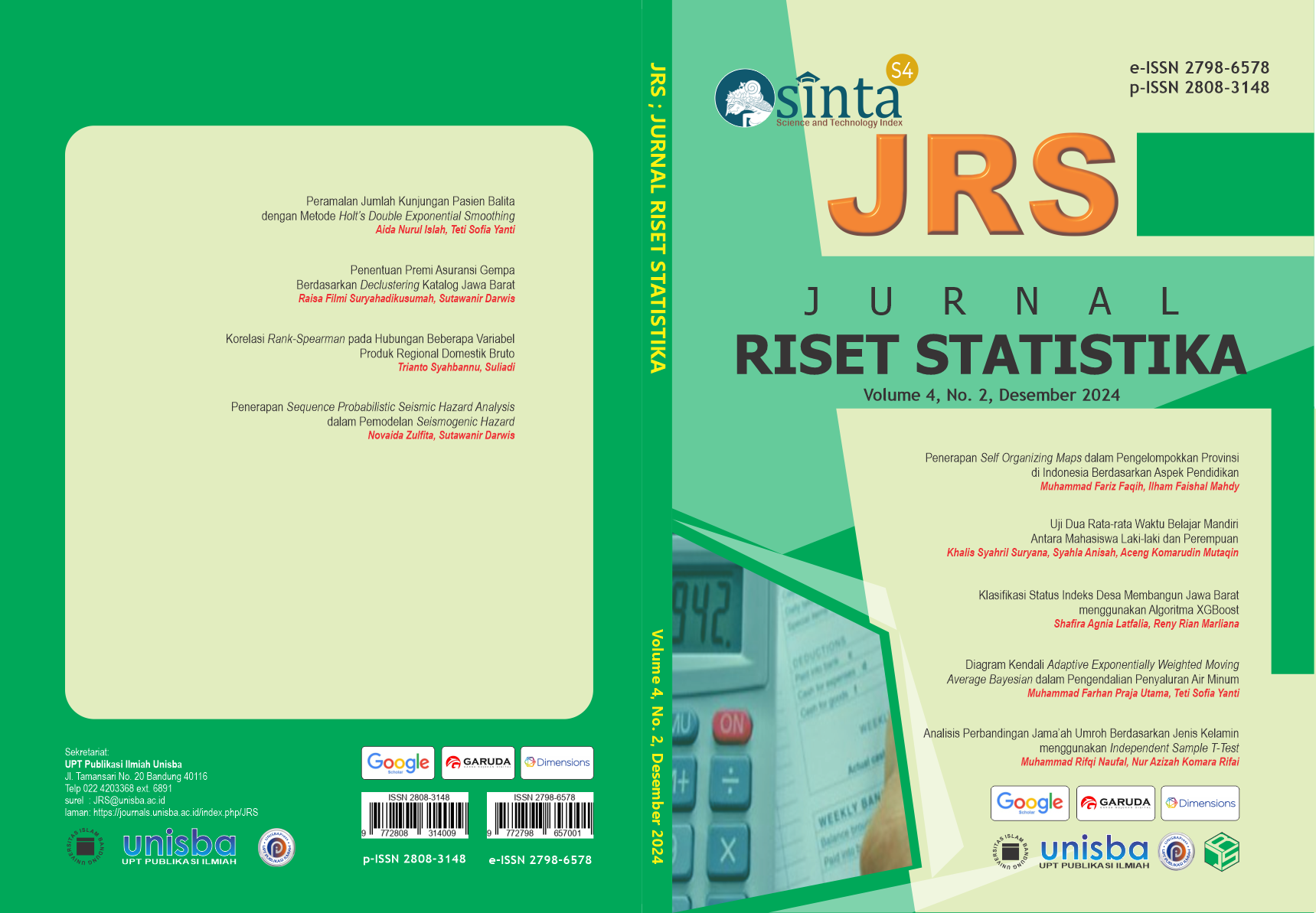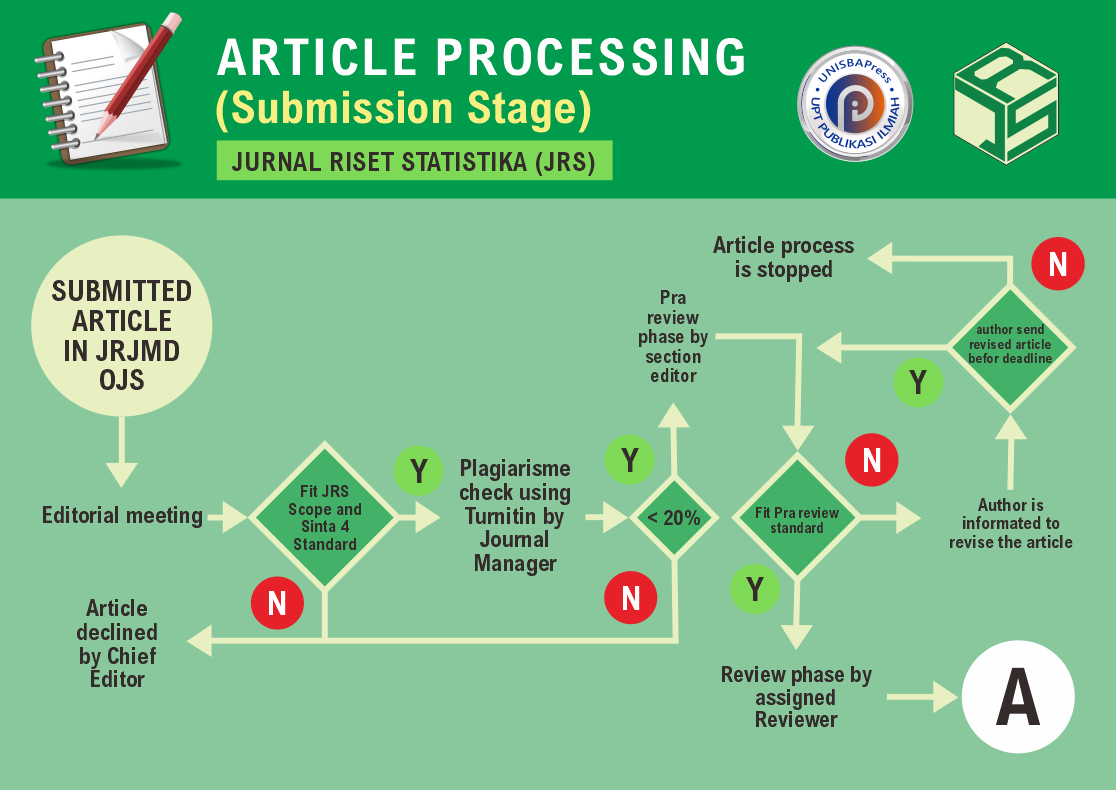Penentuan Premi Asuransi Gempa Berdasarkan Declustering Katalog Jawa Barat
DOI:
https://doi.org/10.29313/jrs.v4i2.5029Keywords:
Declusteirng, Premi Asuransi Gempa, Sequence-based PSHA (SPSHA)Abstract
Abstract. Indonesia is considered as an area which is prone to natural disasters, especially earthquakes. The condition of being at risk of earthquake disaster causes the threat risk of loss due to earthquakes for the people of Indonesia. Earthquake insurance can be a preventive measure for the community in facing the threat of risk of loss due to earthquakes. This study aims to determine the earthquake insurance premium based on the declustering process of the earthquake catalog in the Cianjur Regency, West Java. Declustering is the process of separating the main earthquake data from the predecessor and aftershocks in the earthquake catalog where the data from the separation will then be used for the analysis of seismic hazard calculation. The seismic hazard in this study is calculated by two methods, namely Probabilistic Seismic Hazard Analysis (PSHA) which only considers the main earthquake, and Sequence Based-PSHA (SPSHA) which considers a combination of main earthquakes and aftershocks. The Probability of Exceedance (POE) results from these two methods are then used as the basis for seismic hazard calculations for earthquake insurance premiums. Through Gardner & Knopoff (1974) declustering, 11 clusters of earthquake sequences of were obtained, where each earthquake sequence has 1 main earthquake. By using 1 cluster of earthquake sequences consisting of 1 main earthquake and 74 aftershocks, it was found that the SPSHA method that considers a combination of main and aftershocks can produce a higher POE value than the PSHA method that only considers main earthquakes. Thus, the premium rate resulting from the SPSHA seismic hazard modeling is higher than the premium rate resulting from the PSHA seismic hazard modeling.
Abstrak. Indonesia termasuk kedalam wilayah rawan terjadi bencana alam khususnya gempa bumi. Kondisi rawan bencana gempa menimbulkan adanya ancaman risiko kerugian akibat gempa bagi masyarakat Indonesia. Asuransi gempa bumi dapat menjadi langkah preventif masyarakat dalam menghadapi ancaman risiko kerugian akibat gempa. Penelitian ini bertujuan untuk menentukan premi asuransi gempa berdasarkan proses declustering katalog gempa wilayah Kabupaten Cianjur Jawa Barat. Declustering merupakan proses pemisahan data gempa utama dari gempa pendahulu dan gempa susulan pada katalog gempa dimana data hasil pemisahan tersebut selanjutnya akan digunakan untuk analisis perhitungan bahaya kegempaan. Bahaya kegempaan pada penelitian ini dihitung dengan dua metode yaitu Probabilistic Seismic Hazard Analysis (PSHA) yang hanya mempertimbangkan gempa utama, dan Sequence Based-PSHA (SPSHA) yang mempertimbangkan kombinasi gempa utama dan gempa susulan. Hasil Probability of Exceedance (POE) dari kedua metode ini kemudian digunakan sebagai dasar perhitungan bahaya kegempaan untuk premi asuransi gempa. Melalui declustering Gardner & Knopoff (1974) diperoleh hasil 11 cluster rangkaian gempa dimana setiap rangkaian gempa memiliki 1 gempa utama. Dengan menggunakan 1 cluster rangkaian gempa yang terdiri dari 1 gempa utama dan 74 gempa susulan diperoleh hasil bahwa metode SPSHA yang mempertimbangkan kombinasi gempa utama dan gempa susulan dapat menghasilkan nilai POE yang lebih tinggi daripada metode PSHA yang hanya mempertimbangkan gempa utama. Sehingga, tarif premi yang dihasilkan dari pemodelan bahaya kegempaan SPSHA lebih tinggi daripada tarif premi yang dihasilkan dari pemodelan bahaya kegempaan PSHA.
References
A. Setiawan, “Perbandingan Penggunaan Jarak Manhattan, Jarak Euclid, dan Jarak Minkowski dalam Klasifikasi Menggunakan Metode KNN pada Data Iris,” Jurnal Sains dan Edukasi Sains, vol. 5, no. 1, pp. 28–37, 2022, doi: 10.24246/juses.v5i1p28-37.
I. D. Rosa and Y. Karyana, “Perkiraan Angka Migrasi Neto Perkelompok Umur Provinsi Jawa Barat Tahun 2020 dan 2021,” Jurnal Riset Statistika, pp. 35–42, Jul. 2023, doi: 10.29313/jrs.v3i1.1773.
Tasya Azzahra, “Pemodelan Regresi Hurdle Negative Binomial pada Jumlah Kasus Difteri Jawa Barat 2020,” Jurnal Riset Statistika, pp. 125–130, Dec. 2023, doi: 10.29313/jrs.v3i2.3014.
I. F. Roji, “Penentuan Nilai Premi pada Asuransi Pertanian Berbasis Indeks Iklim di Kabupaten Bogor,” Jurnal Riset Statistika, pp. 65–72, Jul. 2022, doi: 10.29313/jrs.vi.908.
R. S. Nastiti and A. K. Mutaqin, “Penerapan Model Komposit Weibull-Pareto pada data Klaim Asuransi Harta Benda,” Jurnal Riset Statistika, pp. 43–49, 2022, doi: 10.29313/jrs.vi.903.
M. D. Marasabessy and S. Darwis, “Konfidensi Premi Asuransi Gempa Menggunakan Simulasi Monte Carlo,” DataMath: Journal of Statistics and Mathematics, vol. 1, no. 1, pp. 1–10, 2023.
G. L. Yeo and C. A. Cornel, “A probabilistic framework for quantification of aftershock ground-motion hazard in California: Methodology and parametric study,” Earthquake Engineering and Structural Dynamics, 2008, doi: 10.1002/eqe.
G. L. Yeo and C. A. Cornell, “A Probabilistic Framework for Quantification of Aftershock Ground‐Motion Hazard in California: Methodology and Parametric Study,” Earthq Eng Struct Dyn, vol. 38, no. 1, pp. 45–60, Jan. 2009, doi: 10.1002/eqe.840.
Y. Ogata, “Estimation of The Parameters in The Modified Omori Formula for Aftershock Frequencies by The Maximum Likelihood Procedure,” Journal of Physics of the Earth, vol. 31, no. 2, pp. 115–124, 1983, doi: 10.4294/jpe1952.31.115.
I. Iervolino, E. Chioccarelli, and M. Giorgio, “Aftershocks’ Effect on Structural Design Actions in Italy,” Bulletin of the Seismological Society of America, vol. 108, no. 4, pp. 2209–2220, 2018, doi: 10.1785/0120170339.
T. Van Stiphout, J. Zhuang, and D. Marsan, “Seismicity declustering,” Community Online Resource for Statistical Seismicity Analysis, no. February, pp. 1–25, 2012, doi: 10.5078/corssa-52382934.
J. K. Gardner and L. Knopoff, “Is the sequence of earthquakes in southern California, with aftershocks removed, Poissonian?,” Bulletin of the Seismological Society of America, vol. 64, no. 5, 1974, doi: 10.1785/BSSA0640051363.
J. W. Baker, B. A. Bradley, and P. J. Stafford, An Introduction to Probabilistic Seismic Hazard Analysis (PSHA), Version 1. Cambridge, England: Cambridge University Press, 2021.
A. F. Nurfauzan and S. Darwis, “Clustering Probabilistic Seismic Hazard Analysis Temporal Epidemic-Type Aftershock Sequence untuk Premi Asuransi,” Jurnal Riset Statistika, pp. 41–48, Jul. 2024, doi: 10.29313/jrs.v4i1.3864.
M. S. Yucemen, “Probabilistic Assessment of Earthquake Insurance Rates for Turkey,” Natural Hazards, vol. 35, no. 2, 2005, doi: 10.1007/s11069-004-6485-8.
M. S. Yucemen, “Probabilistic Assessment of Earthquake Insurance rates for Jordan,” 2005, pp. 291–313. doi: 10.1007/s11069-004-6485-8.













